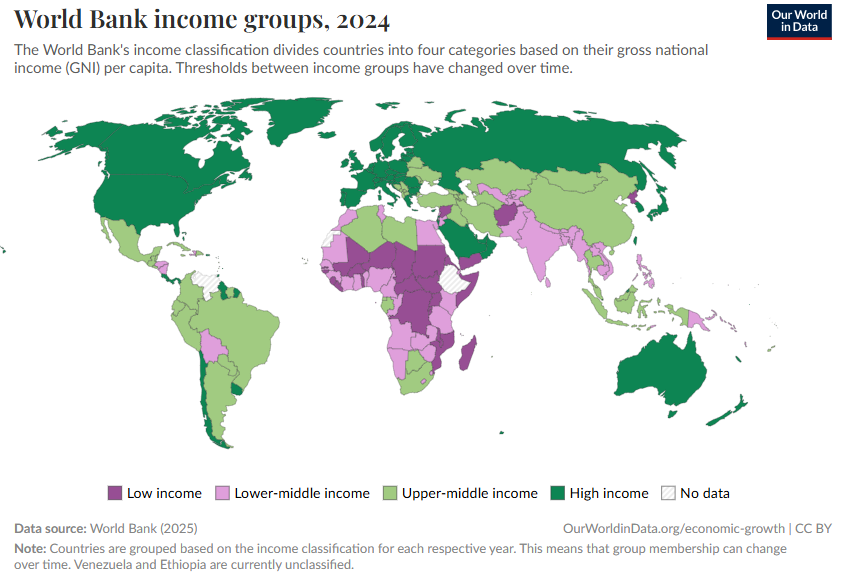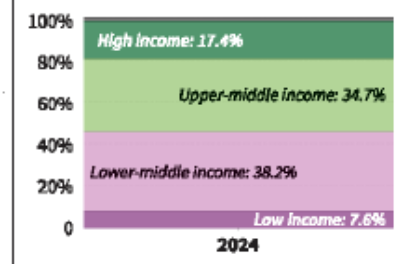Font size:
Print
World Bank Income Classification
World Bank Income Classification: Unveiling Economic Progress Across Nations
Context: To enable consistent comparison across nations, the World Bank annually classifies countries into four income groups—low, lower-middle, upper-middle, and high—based on gross national income (GNI) per capita, converted to U.S. dollars using the Atlas method.

How does the World Bank classify countries into income groups?
- The World Bank classifies countries into four income groups based solely on Gross National Income (GNI) per capita.
- This system, introduced in the late 1980s, was originally tied to eligibility for concessional lending from the World Bank and the International Development Association (IDA).
- Income thresholds for FY2025 (in USD):
- Criteria for Classification:
-
- Atlas GNI per capita
-
- Exchange rate trends over three years
-
- Inflation (GDP deflator)
-
- Population revisions or corrections
- Methodological updates by national statistical offices
- The four income groups are: Low-income countries (LICs), Lower-middle-income countries (LMICs), Upper-middle-income countries (UMICs) & High-income countries (HICs).
- GNI per capita includes the total domestic and foreign income earned by residents, divided by the midyear population.
What criteria and thresholds determine these income group classifications?
- The classification is absolute, not relative. A country’s placement is based only on whether its GNI per capita surpasses or falls below fixed dollar thresholds — regardless of how other countries perform.
- These thresholds are adjusted annually to reflect global inflation, using the SDR deflator, which is a weighted average of GDP deflators of major economies (US, Euro Area, China, Japan, UK).
- Case Study: Iran, in 2023, saw a 39.5% nominal GNI increase, driven by oil exports and currency depreciation. This pushed it from lower-middle to upper-middle income.

What are the limitations and challenges?
- Does not account for income distribution: The method uses national averages and ignores inequality. Many middle-income countries still have large populations living in poverty.
- Example: India is a lower-middle-income country, but hosts over 129 million people in extreme poverty (World Bank, 2024).
- Informal and unrecorded economies: GNI may underestimate income in countries with large informal sectors or poor statistical capacity.
- Example: In several African nations, informal employment makes up over 80% of the labor force, reducing GNI reliability.
- Artificial thresholds: The thresholds, though adjusted for inflation, are still arbitrary historical constructs.
- No adjustment for purchasing power: Unlike PPP (Purchasing Power Parity)-based income measures, Atlas GNI doesn’t reflect what people can actually buy in their country.
Why does classifying countries by income category matter?
- Global Aid Allocation & Policy Targeting: International organisations (e.g., WHO, UNICEF, GAVI) and donors use these groups to target aid programs, differential pricing, and technical support.
- Comparative Research and Global Monitoring: The classification facilitates standardised comparisons across countries in development indicators, such as education, health, climate resilience, and infrastructure.
- Used in: World Development Indicators (WDI), Human Capital Index, Poverty and Shared Prosperity Reports.
- Policy Signalling and Global Perception: A shift in income group can influence investor confidence, credit ratings, and diplomatic status.
- Highlighting Economic Transitions: The long-term movement of countries up the income ladder tracks global development progress.
Subscribe to our Youtube Channel for more Valuable Content – TheStudyias
Download the App to Subscribe to our Courses – Thestudyias
The Source’s Authority and Ownership of the Article is Claimed By THE STUDY IAS BY MANIKANT SINGH





